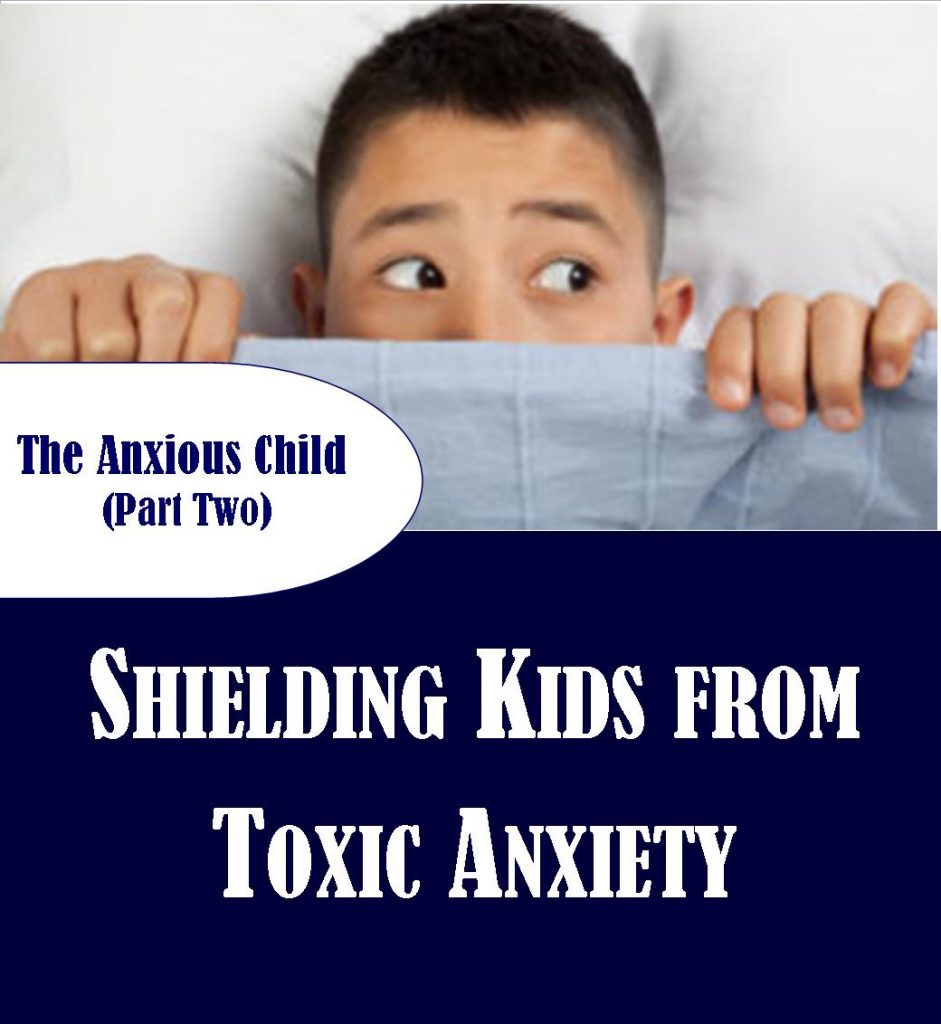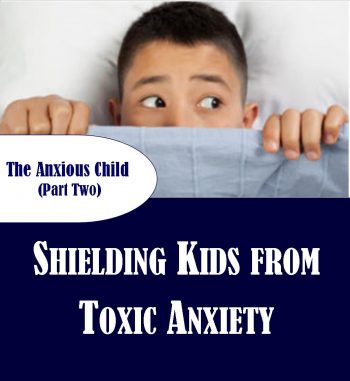
“Do not let your hearts be troubled” John 14:1
In my last post on anxiety, I explained the difference between the ordinary anxiety all kids experience and the toxic kind that prevents kids from flourishing. I looked at some possible reasons for the increase in clinical anxiety in children in recent decades. I suggested in that post that we can protect our children from anxiety by avoiding helicopter parenting and ensuring they have plenty of time for unstructured play.
I want to offer some more tips in this post about how we can shield our kids from toxic anxiety. These tips are less obvious, and they are lessons I learned with my own anxious child — lessons learned through failure and second chances. I hope they help you.
Decrease Unnecessary Separation
A secure attachment to a parent provides children with a secure base from which they can burst forth to explore the world and chart their course in life. Attachment is the womb of maturation. I explained in my first anxiety post that when our children are exposed to more separation than they can bear, they become preoccupied with searching and yearning for a sense of safety and connection. They become less independent and more anxious. They become fixated on substitute attachments (peers, technology) or they become stuck in self-numbing behaviors.
We can protect kids from unnecessary anxiety by avoiding unnecessary separation from us; this is especially important for sensitive children and those who tend to be more anxious. I’m not only talking about physical separation. For tiny children, it’s true that we should keep them physically close as much as possible, but as children get older, they are looking for closeness through more than physical proximity. They want to connect through a sense of sameness, belonging, significance, emotional intimacy, and being known. These are the six roots of attachment which I talked about here. They can experience a threat of loss or disconnection from people they care about in any one of these attachment roots.
So we try not to do or saying anything to a child that makes him feel that he doesn’t belong with us or that he isn’t important to us; that his feelings aren’t important or that we don’t want him around. We protect him from too much exposure to peer relationships in which he is made to feel lonely or rejected. We don’t have to hide him away in a drawer, but it’s okay to limit a child’s exposure to problem peers. We can also protect him by nurturing our relationship with him. When he cares more about our opinions of him than his friends’, he will be shielded from some of the wounding that all peers inflict on one another.
Bridge Unavoidable Separation
We can’t avoid all separations. Our kids have to learn to cope with this separation, but we can help them along. One wise practice is to bridge separations.
Bridging involves helping children through a separation by pointing out the next point of connection. So, if you have to go on a business trip and you know your child will be anxious about this, a few weeks, then a few days, then a few hours before you leave ensure you let your child know the separation is coming. Don’t spring it on him. This gives him time to talk about and to accept it before the moment comes.
Then, bridge the separation by pointing his mind to the next point of contact: “I’m going to send you a funny picture of my feet at the airport.” “I’m going to see you in two days, and we’ll get to practice your pitching. I can’t wait!”
Bridge with objects
You can also give him something physical to hold on to until you return. Once my husband was taking my youngest child on a camping trip while I stayed home with another sick child. She was very upset sitting in the van while I strapped her into her car seat as we were saying our final goodbyes. She was very anxious about being away from me, but I knew she would have a wonderful time with Daddy. I was in my bathrobe (yep, I was outside in my bathrobe), so I took it off and put it over her, tucking it in around her legs. She took my bathrobe with her on the camping trip. She told me when she returned that she slept with the bathrobe and it made her feel close to me. It was a small thing, but it helped bridge the separation for a few days.
Bridging through behavioral challenges
Sometimes behavioral issues can create a feeling of separation. I am not wild about time-outs because they shock a child into physical separation if the tone is not right, and timeouts might make the child feel like they don’t belong with us. On the other hand, I know some folks handle timeouts beautifully. No matter how we handle behavioral issues, we can bridge the feeling of separation that comes with interpersonal tension by reminding our child that we’ll get through it together. “This is tough for both of us. But we’ll get through it. I still love you. I’m so glad I’m your mom.”
Have a Relaxed Attitude about Your Child’s Anxiety
I learned the hard way that when we respond to our child’s alarm with alarm, it makes them more alarmed! Sometimes when on of my kids is freaking out, my own alarm system starts screaming, and I want to lose it, really lost it. But I know I have to be the grown up; I have to take the lead and try to stay calm. If I can do this, I’m able to lead my child to calmer waters. If she thinks I’m in over my head or I can’t handle her anxiety, this will add fuel to the fire.
Hard as it is, we can model calm when our child is drowning in fear. We can also tell our child that fear, anxiety, and concern is part of life. We can share with our child that we were scared about stuff when we were kids, too. I would, however, avoid being too real and telling your child how worried you are about something right now. Don’t tell her that you’re worried about paying the mortgage or whether grandma will be alive at Christmas. By sharing your experience, focus on your childhood self.
Anxiety Is Not a Sin
This is a good place to address something that might be weighing on your mind. Some people believe that being anxious is a sin. The thinking goes something like this: If we trust God we would not be anxious. They cite passages like the one that opens this article. At the last supper, Jesus exhorts his disciples, “Do not let your hearts be troubled” (John 14:1). So, if you don’t listen to Jesus here, if your heart is troubled, you have disobeyed. These folks are reading this line as a commandment similar to one of the 10 commandments. Don’t covet your neighbor’s wife. Don’t steal. Don’t let your hearts be troubled.
But if you read this passage in context, it seems to me that Jesus is encouraging, not admonishing, his disciples; he is saying, hey, cheer up guys. Encouraging them about what? The passage continues, “You have faith in God, have faith also in me. In my Father’s house there are many dwelling places. If there were not, would I have told you that I am going to prepare a place for you? And if I go and prepare a place for you, I will come back again, and take you to myself” (John 14:2-3). He is telling them that he has to leave them. They are facing separation from their master; they are scared, so he is comforting them.
I am no exegete. You might see something here that I don’t. But what I see is our dear Lord bridging the separation, comforting his disciples. He’s saying don’t be afraid, because I’m coming back for you; I’ll see you again. There’s room for everyone! Be of courage! That’s what he’s saying. He is comforting these men he loved so, not warning them that they are sinners if they are scared.
So, no it is not a sin to be anxious. It’s a natural physical and emotional response to the threat of loss, separation, or wounding. Although anxiety is not a sin, it would be a mistake to think that God wants us to feel this way. He definitely doesn’t want us to suffer from clinical anxiety. He wants us to lean on him, and he wants to comfort us; he wants us to find hope in his promises. And this is what we want for our children.
Help Your Child Find Healthy Ways to Cope
If a child has obsessive habits to deal with his anxiety, help him channel that energy into healthier habits. Don’t wait until he’s in the middle of a panic attack. When he’s in a good place, brainstorm some concrete steps he can take when he starts feeling anxious.
Physical activity is one of the best ways for a child to deescalate when in a panic. So maybe your child can ride his scooter, jump on a trampoline, or go for a bike ride in a nature reserve. He might try some calming activities like sitting in a special tent filled with pillows, playing with fidget toys, or doing crafts like knitting or needlepoint that involve a lot of repetition. Some kids might like to have a box with activities that can do when they are alarmed; the box can be filled with a journal, craft kits, sand activities, etc.
Lead Children to God
Adults who are spiritually mature are known to have far less anxiety than other folks, even in very trying circumstances. Their faith in God gives them a peace of mind; they know they will be okay. So, we can help a child grow closer to God, and lean on God when he’s feeling anxious.
When children are little, we can invite them to lean on us, to trust us with their fears and anxieties. From there, we can help them place their fears in God’s hands. They experience this trust with us; then we help them experience it with God. We create a model in our child’s mind about how God feels about them. If our children trust us with their fears, they will come to trust God.
Many Bible stories show how much God loves us, and how he is stronger than our biggest fears. Think of Daniel in the lion’s den and Queen Esther fighting for the lives of the Jewish nation; both these heroes were scared, but God protected them and worked through them. Find books to read with your child that might help him recognize God caring for him even when he’s scared. For example, check out It Will be Okay: Trusting God Through Fear and Change.

